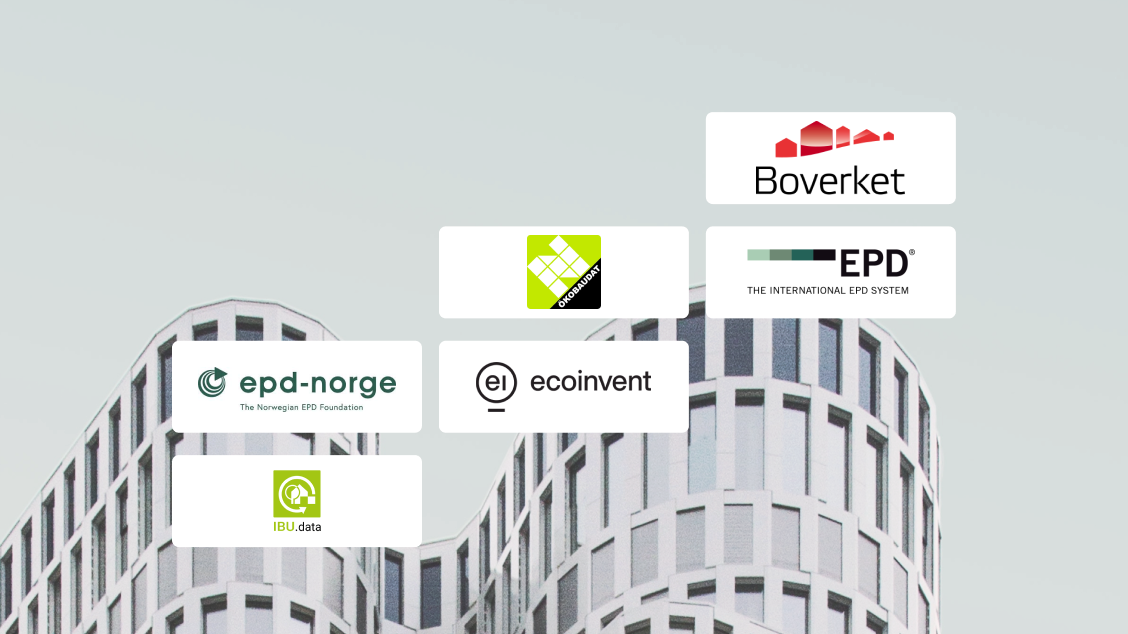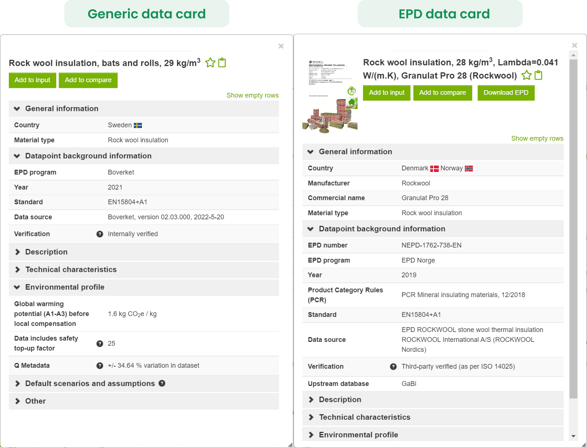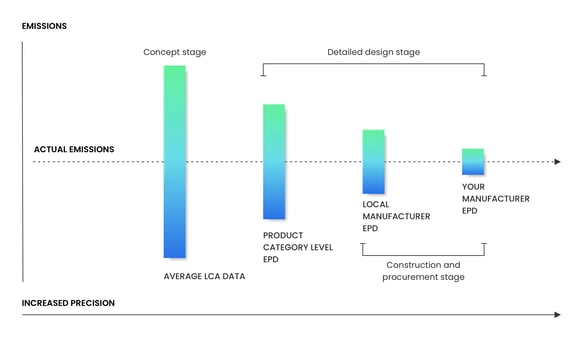
At One Click LCA we have long advocated for the use of Environmental Product Declarations (EPD) over generic data for building life-cycle assessments (LCA). We welcome recent national building LCA requirements, for example in Norway and in Sweden, which have incentivized the use of EPDs over generic data. As part of our mission to make LCA more accessible for all, this article explains the differences between generic data and EPDs and summarizes how One Click LCA can help you to comply with the new requirements in Norway and Sweden.
What’s the difference between an EPD and generic data?
An Environmental Product Declaration (EPD) provides an independently verified summary of the environmental impact of a specific product throughout its life cycle, calculated via life-cycle assessment (LCA).
In contrast, generic data represents the average environmental performance or a result from modelling the generic production process for all products within that category and is not representative of a single product.
Fig 1 shows an example of generic data for Nordics compared with product-specific EPDs.
Fig 1 shows an example of generic data for Nordics compared with product-specific EPDs.
Product-specific EPDs document emissions and impacts more accurately than generic data.
With over 200 000 data points, the One Click LCA database is the world’s largest collection of product-specific data in the form of Environmental Product Declarations or EPDs. This data is available in a machine-readable format, can be integrated with BIM, and is updated weekly. One Click LCA offers many types of EPDs, including generic, product-specific, plant-specific, internal, and third-party verified EPDs.
For Norway, the One Click LCA database has more than 3300 manufacturer-specific data points and 40 generic data points to date (Dec 2022). The main source databases for the Norwegian data are EPD Norway (NEPD), Environdec, International EPD System, and IBU. For Sweden, the database covers over 4400 manufacturer-specific data points, and 275 generic data points from the Boverket database, Environdec, IBU, NEPD, and UL).
All EPDs – whether published in Norway or elsewhere – can be used in One Click LCA. Since Norway does not have a generic national database, like Boverket or Okobaudat, the user is free to choose from a selection of databases.
One Click LCA’s Pre-Verified EPD generator offers a range of EPD solutions to achieve compliance with building LCA regulations in Sweden and Norway.
Data compliance for Swedish and Norwegian regulations
The climate declaration in Sweden (Klimatdeklaration av byggnader) came into force on 1 January 2022. It effectively incentivizes the use of product-specific data in the form of EPDs by stipulating that only generic data from Boverket’s database can be used to comply with its requirements. No other generic data is permissible.
Using product EPDs becomes even more preferable when you consider that the generic values in Boverket’s database are conservative, with emissions rated at 25% higher than the typical value. This covers any issues with inaccurate modelling and also promotes the use of specific EPD values.
Norway introduced new national climate requirements (TEK 17) in July 2022. To comply with the regulation, only products that are not hazardous to health can be used. Again, EPD usage is incentivized by the TEK 17 requirements as using EPDs makes it easier to demonstrate compliance with the new regulation. In addition, TEK 17 also adds a 25% emissions ‘top-up’ when generic data is used, similar to Boverket and many other generic databases.
Which data to use and when
When selecting building material data for LCA calculations, the principle is always to choose the data with the highest accuracy. At One Click LCA we advise using data in the following order of priority.
- EPD of the product from the specific manufacturer, if available.
- Technically similar product data from a local manufacturer if the manufacturer is not confirmed yet.
- Product category level EPD or LCA.
- Average LCA data/generic data for the product in question (same product from different manufacturers)
However, the greatest opportunities for reducing impact are during the early design stages, when there is often a lack of accurate data as decisions over specific product choices have yet to be made. This is where good quality generic data can play an important role.
How to use data during different project stages
During the concept design stage, when you do not have information about the exact product/materials being used, generic data can be used for LCA calculations. In this case, using generic data helps to avoid making design decisions based on the performance of a single product that may not be representative.
In detail design, construction, and procurement stages, EPDs should be used for LCA calculations when you are ready to buy the material from a specific supplier. You may use generic data if and only if you do not have manufacturer-specific EPD data. It should be kept in mind that the level of detail required for the construction material increases as the project progresses (as shown in Fig 2 ).

Fig 2. Generic vs. EPD data used during various project stages
Find out how we ensure the availability, quality, and consistency of LCA data in One Click LCA.
Carbon Experts Newsletter
Industry news & insights — straight to your inbox
Want to learn more?
Jani Tierala • Aug 02 2024
Panu Pasanen • Jan 19 2023
Panu Pasanen • Sep 11 2018
Melina Zacharia • Feb 09 2024
